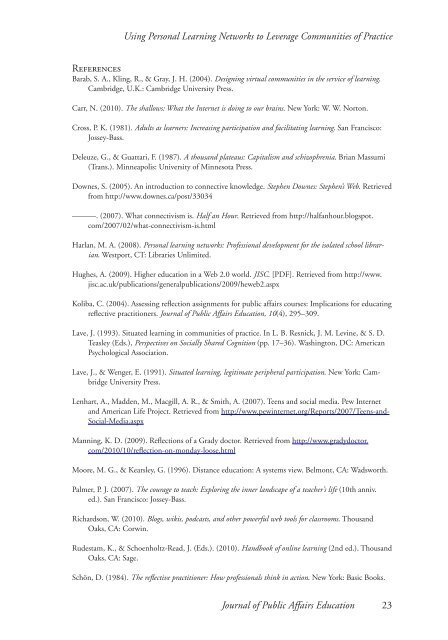Journal of Public Affairs Education
You also want an ePaper? Increase the reach of your titles
YUMPU automatically turns print PDFs into web optimized ePapers that Google loves.
Using Personal Learning Networks to Leverage Communities <strong>of</strong> Practice<br />
References<br />
Barab, S. A., Kling, R., & Gray, J. H. (2004). Designing virtual communities in the service <strong>of</strong> learning.<br />
Cambridge, U.K.: Cambridge University Press.<br />
Carr, N. (2010). The shallows: What the Internet is doing to our brains. New York: W. W. Norton.<br />
Cross, P. K. (1981). Adults as learners: Increasing participation and facilitating learning. San Francisco:<br />
Jossey-Bass.<br />
Deleuze, G., & Guattari, F. (1987). A thousand plateaus: Capitalism and schizophrenia. Brian Massumi<br />
(Trans.). Minneapolis: University <strong>of</strong> Minnesota Press.<br />
Downes, S. (2005). An introduction to connective knowledge. Stephen Downes: Stephen’s Web. Retrieved<br />
from http://www.downes.ca/post/33034<br />
———. (2007). What connectivism is. Half an Hour. Retrieved from http://halfanhour.blogspot.<br />
com/2007/02/what-connectivism-is.html<br />
Harlan, M. A. (2008). Personal learning networks: Pr<strong>of</strong>essional development for the isolated school librarian.<br />
Westport, CT: Libraries Unlimited.<br />
Hughes, A. (2009). Higher education in a Web 2.0 world. JISC. [PDF]. Retrieved from http://www.<br />
jisc.ac.uk/publications/generalpublications/2009/heweb2.aspx<br />
Koliba, C. (2004). Assessing reflection assignments for public affairs courses: Implications for educating<br />
reflective practitioners. <strong>Journal</strong> <strong>of</strong> <strong>Public</strong> <strong>Affairs</strong> <strong>Education</strong>, 10(4), 295–309.<br />
Lave, J. (1993). Situated learning in communities <strong>of</strong> practice. In L. B. Resnick, J. M. Levine, & S. D.<br />
Teasley (Eds.), Perspectives on Socially Shared Cognition (pp. 17–36). Washington, DC: American<br />
Psychological Association.<br />
Lave, J., & Wenger, E. (1991). Situated learning, legitimate peripheral participation. New York: Cambridge<br />
University Press.<br />
Lenhart, A., Madden, M., Macgill, A. R., & Smith, A. (2007). Teens and social media. Pew Internet<br />
and American Life Project. Retrieved from http://www.pewinternet.org/Reports/2007/Teens-and-<br />
Social-Media.aspx<br />
Manning, K. D. (2009). Reflections <strong>of</strong> a Grady doctor. Retrieved from http://www.gradydoctor.<br />
com/2010/10/reflection-on-monday-loose.html<br />
Moore, M. G., & Kearsley, G. (1996). Distance education: A systems view. Belmont, CA: Wadsworth.<br />
Palmer, P. J. (2007). The courage to teach: Exploring the inner landscape <strong>of</strong> a teacher’s life (10th anniv.<br />
ed.). San Francisco: Jossey-Bass.<br />
Richardson, W. (2010). Blogs, wikis, podcasts, and other powerful web tools for classrooms. Thousand<br />
Oaks, CA: Corwin.<br />
Rudestam, K., & Schoenholtz-Read, J. (Eds.). (2010). Handbook <strong>of</strong> online learning (2nd ed.). Thousand<br />
Oaks, CA: Sage.<br />
Schön, D. (1984). The reflective practitioner: How pr<strong>of</strong>essionals think in action. New York: Basic Books.<br />
<strong>Journal</strong> <strong>of</strong> <strong>Public</strong> <strong>Affairs</strong> <strong>Education</strong> 23



